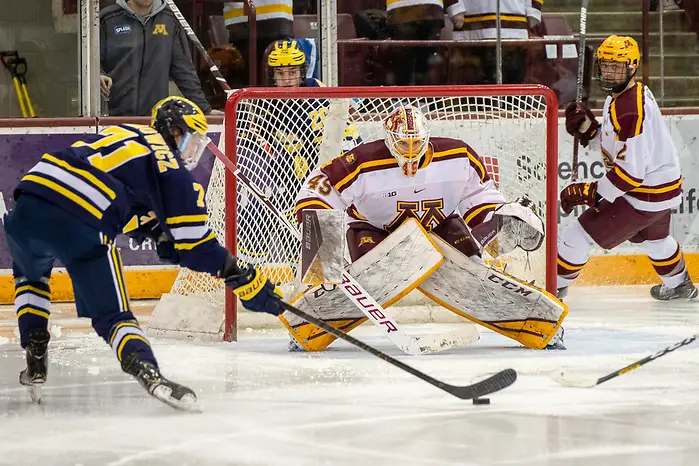
Each week during the season, we look at the big events and big games around Division I men’s college hockey in Tuesday Morning Quarterback.
Jim: Paula, the home stretch of this hockey season is near as the calendar turns to March.
Four of the six leagues have completed their regular seasons and are about to begin playoffs while the other two — Hockey East and NCHC — both have one week left in the regular season and have crowned their champs.
The craziest finish this past weekend was the Big Ten, where idle Penn State led by four points over Minnesota and Ohio State, but appeared susceptible to losing the title of either team earn five of six points.
Amazingly, that hope was gone by Friday after Ohio State fell to last-place Wisconsin and upstart Michigan took two of three points with a shootout victory. And furthermore, neither team was able to insomuch as catch Penn State to earn co-championship status before the end of the weekend.
It felt crazy to me that neither team, when the chips were down, could pull off two wins. But you know this league better. And unpredictability certainly reared its head.
Paula: What’s even more insane is that Ohio State, Minnesota and Michigan all ended the season tied with 38 points – or maybe that’s completely on brand for B1G hockey this year, a season when the only consistency seemed to be the struggles of last-place Wisconsin.
Going into the weekend, Wisconsin had three road wins and I knew they were ripe to spoil. The Badgers were 3-3-0 in their previous six games, averaging 3.83 goals in that span, while the Buckeyes were 3-2-1 in their previous six and averaging 2.33 goals in those contests.
This weekend, Ohio State hosts Wisconsin again for a best-of-three series and even though the Buckeyes are the No. 2 seed overall in the Big Ten and the top seed this weekend, the Badgers bring a four-game unbeaten streak into the series, thanks to their win and tie in Columbus last weekend.
With the exception of their recent series against Notre Dame, the Wolverines have been the hottest team in the Big Ten and certainly looked it against Minnesota. In the second half of the season, Michigan is 9-3-2 and has worked hard to earn its first-round home series against archrival Michigan State.
It seems like a cliched thing to say, but I really think that anyone can advance from this weekend but the team I wouldn’t bet against is Michigan.
Now, Jimmy, what about the nuttiness that will be the final regular-season weekend in Hockey East?
Jim: I’ve almost given up on picking Hockey East. The league is as much of a crapshoot as any I know.
The team that befuddles me the most is Northeastern. The Huskies won the Beanpot and then played an excellent series against UMass Lowell, making it seem like maybe they could make a run at home ice and even possibly the league title.
Two weekends later, Northeastern was swept by Boston College, the latter game ending 10-1 in favor of the Eagles, and this past weekend, Northeastern went on the road and lost two games to Vermont, a team that was winless in Hockey East prior.
If this happens in January, I’m not that concerned. But this at the end of February, and for all intents and purposes, March.
Raise the red flag.
This very talented Northeastern squad suddenly is struggling. A big part of that is the absence of Tyler Madden, who was dominating prior to being injured against Lowell in their series opener on Valentine’s Day. But one player shouldn’t make or break a team this significantly. That is what is most concerning about where this Huskies team is headed.
Paula: As the playoffs approach or begin, I think we do see the impact that a single player can have in a given game or on the whole team’s performance.
While it’s true that one player shouldn’t make or break anything, sometimes players emerge at this time of year to give their teams an added bit of dimension. The absence of other players, like Madden at Northeastern, can highlight a team’s lack of depth or upset the chemistry of a given team.
Sometimes it’s easiest to see the emergence of freshmen as the season ends, like Alex Newhook at Boston College who scored nine of his 19 goals in February.
You can also see what’s happened with Notre Dame since senior Cale Morris seemed to regain some of his confidence. In his last nine games, his goals-against average is 1.88 and the Irish are 4-2-3. That may not seem like something to brag about, but Notre Dame had gone through two significant winless streaks – including a five-game stretch immediately prior to these last nine contests – in which Morris’ GAA was 3.27.
Jim: You mentioned a name of a player who may have already locked up a national award: Alex Newhook.
He should easily win the national rookie of the year award, despite not really being mentioned in the preseason.
Since the calendar turned to 2020, Newhook is the nation’s leading scorer by four points. His 28 points in 17 games is four better than both Harvard’s Jack Drury (24 points in 16 games) and Nick Abruzzese (24 points in 17 games).
That’s quite remarkable.
I don’t think that Newhook is on many people’s Hobey radar but maybe should be. There are a lot of dark horses I look at to make the Hobey Top 10 in a year where there really isn’t a clear winner.
I am a voter on the Hobey this year, so I want to stay away from overly influencing the votes, but who are some of the players who you think might be dark horses for the award?
Paula: What a great question, but let’s make it clear that we are talking dark horses and not those whose names are already a part of the Hobey conversation.
I know it’s unlikely that the Hobey committee would consider a goaltender now that the Mike Richter Award is fully established, but I can’t help but mention Minnesota State sophomore Dryden McKay.
McKay is following an outstanding rookie season with an out-of-this-world sophomore effort. McKay leads the nation with a goals-against average (1.30) identical to that of Ryan Miller when the Michigan State netminder won in 2001, and McKay’s save percentage (.943) is a hair lower than Miller’s (.950).
Two of the last three Hobey Baker winners have been defensemen so it’s difficult to argue that a high-profile defenseman like Scott Perunovich is a dark horse, but I think he is. The Minnesota Duluth junior was a key part of the Bulldogs’ back-to-back national championships and a driving force behind Duluth’s steady climb this season. He’s second in the nation in assists per game (1.03) and second nationally among defensemen in scoring (1.22). Given the history of the Hobey, though, it seems unlikely that the committee would choose another defenseman this year.
That having been said, there’s also Boston University junior defenseman David Farrance, who leads all blueliners in points per game (14-26—40), who’s tied for ninth with Newhook in points per game (1.25), with nine power-play goals on the season. Farrance has elevated his game, scoring 10 more goals already this season than he had in all of his sophomore year. He’s a great player on a team that is underperforming this season, too.
There are goal scorers who are likely to be real outliers because of where they play: Arizona State’s Johnny Walker, who deserves serious consideration; Northern Michigan’s Griffin Loughran, a bit part of NMU’s competitive season; Colorado College’s Chris Wilkie, having the season of his life; Lake Superior State’s Max Humitz, who’s been outstanding for four years straight.
I was really disappointed that the award didn’t go to Air Force’s Eric Ehn in 2007, when he was a junior. He had 24 goals, 40 assists, and was just a little over a year away from active duty. It was then that I realized that the Hobey Baker committee weighed the criteria of “strength of character” a little less, perhaps, than on-ice performance – even though Ehn’s on-ice performance that year was stellar, and I say this as a former Hobey Baker Award committee member.
But that – as we are fond of saying – is a discussion for another a day.


